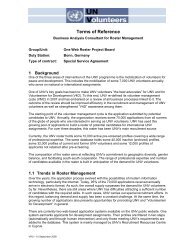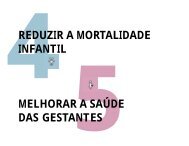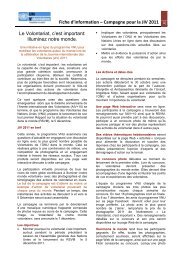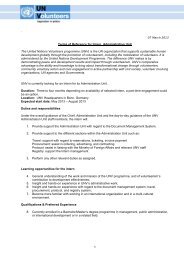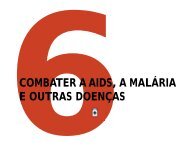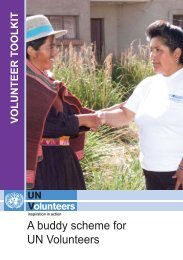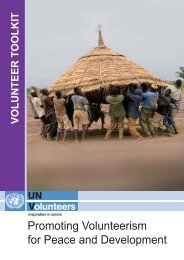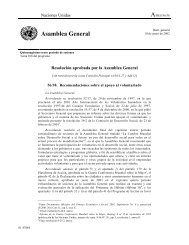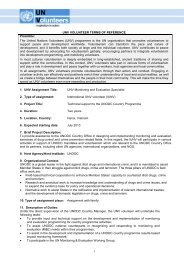View associated PDF document - United Nations Volunteers
View associated PDF document - United Nations Volunteers
View associated PDF document - United Nations Volunteers
You also want an ePaper? Increase the reach of your titles
YUMPU automatically turns print PDFs into web optimized ePapers that Google loves.
UN <strong>Volunteers</strong> Policy Paper<br />
‘Caring Cities’<br />
Volunteering in Urban Development and the role of the <strong>United</strong> <strong>Nations</strong> Volunteer Programme<br />
PART II –<br />
THE UNITED NATIONS VOLUNTEERS PROGRAMME<br />
Thematic view and illustrations<br />
PART II –<br />
THE UNITED NATIONS VOLUNTEERS PROGRAMME<br />
Thematic view and illustrations<br />
Page 48<br />
Page 49<br />
4.2. The social domain<br />
There is a whole set of social problems, which occur predominantly<br />
in urban areas. Largely they are derived from stressors<br />
related to urbanisation such as overcrowding, pollution, longdistance<br />
commuting in precarious circumstances, lack of sociocultural<br />
bonds, lack of access to basic services, etc. A selected<br />
number of social problems related to urbanization are discussed<br />
below.<br />
Abandoned children<br />
While this is an overwhelming – and continuously expanding –<br />
problem in urban settlements throughout the developing world,<br />
it seldom happens in rural areas. It is clearly connected to the<br />
urbanization process, and often takes place due to the breakdown<br />
of family bonds (<strong>associated</strong> with the loss of ethniccultural<br />
bonds in cities and/or to other effects of the pressures<br />
of urban living). Even when (low-income) families do not fall<br />
apart, the adults cannot frequently take proper care of the<br />
children — again due to urban pressures: stress and/or need to<br />
stay away from home to make a living (e.g. Werna et al., 1999).<br />
Solving this problem clearly requires preventive action, which<br />
in turn entails direct, long-term work with low-income families<br />
and communities, and with children at risk. This shows the<br />
advantages of UNV’s roles in tasks such as community animation<br />
and orientation, participatory work, income generation and<br />
grassroots technical assistance (psychologists, councillors and<br />
social assistants).<br />
In parallel to the above, curative actions are also necessary to<br />
assist the large numbers of children who are already on the<br />
streets. Again, direct, long-term work — in this case with the<br />
abandoned children themselves — is absolutely required to help<br />
this particular group which consists of often psychologically<br />
traumatized individuals, who are exposed to problems such as<br />
discrimination, homelessness, malnutrition, drug-taking, infections<br />
diseases, prostitution, crime and violence. Thus, UNV’s grassroots<br />
technical assistance is of primary importance (i.e.<br />
professionals working directly with the children). It is worth<br />
re-emphasising the importance of UNV’s volunteer ethos. The<br />
spirit of solidarity transmitted through voluntary work is crucial<br />
to build trust and confidence in such children in especially<br />
difficult circumstances.<br />
I --------------------------------------------<br />
Volunteer support to street<br />
children in Latin America<br />
-----------------------------------------------<br />
Street children in Tegucigalpa,<br />
Honduras and Managua,<br />
Nicaragua have been piloting<br />
their own solutions to problems<br />
of exclusion, glue-sniffing and<br />
precarious income earning for<br />
themselves and their families<br />
with the help of UN <strong>Volunteers</strong><br />
whose assignments were<br />
funded by the Government of<br />
Belgium.<br />
In other countries such as<br />
Ecuador and Brazil, UN<br />
<strong>Volunteers</strong> helped street children<br />
by providing training in handicrafts,<br />
introducing teenagers to<br />
potential employers and teaching<br />
language skills.<br />
In addition to the above ‘handson’<br />
activities, street children in<br />
Latin America have also been<br />
supported through broader<br />
initiatives. For example, UNV is<br />
currently supporting the governments<br />
of Central American<br />
countries to address issues<br />
about sexual exploitation, child<br />
labour and unemployment.<br />
Since early 1999, 21 UN <strong>Volunteers</strong><br />
have been working on<br />
such regional activities, focusing<br />
their efforts mainly at the legislative<br />
level. The UN <strong>Volunteers</strong><br />
have helped to draft laws and<br />
train judges, lawyers and government<br />
officials on how to apply<br />
the Convention on the Rights of<br />
the Child.<br />
J --------------------------------------------<br />
Volunteer support to<br />
adolescents involved in law<br />
violations in Central America<br />
-----------------------------------------------<br />
It is a known fact that many<br />
adolescents who commit minor<br />
offences are brutally treated by<br />
law enforcement officers. This<br />
often contributes not to prevent<br />
them from repeating the offences,<br />
but actually force them to climb<br />
the crime-ladder – as the<br />
youngsters feel mistreated by<br />
the official system, and feel that<br />
the only option is to immerse<br />
themselves in crime. Considering<br />
this, within the framework of the<br />
project related to the Convention<br />
on the Rights of the Child (see<br />
text I), UNV has provided<br />
support to youngsters in trouble<br />
with the law.<br />
In parallel, in El Salvador and in<br />
other Central American countries,<br />
UN <strong>Volunteers</strong> go to detention<br />
centers and meet with hardened<br />
teenage criminals who have<br />
been denied their childhood.<br />
They bring with them their<br />
UNV can also use the ‘mirror volunteer’ approach to enhance<br />
the effectiveness of the curative actions. This means using<br />
ex-street children as UN <strong>Volunteers</strong>. As highlighted before, this<br />
approach provides a unique added value that can only be<br />
achieved through the personal interaction between people<br />
who have experienced the same problem or need.<br />
UNV is currently implementing a Child-friendly Cities initiative in<br />
Port Harcourt, Nigeria (presented in text J). It also implemented<br />
a similar activity in the Palestine. In addition, UNV has supported<br />
street children through other types of projects. Text I provides<br />
examples from Latin America.<br />
Violence and crime<br />
High rates of violence already constitute a crucial problem in<br />
many urban areas in developing countries, and the problem is<br />
continuously spreading to other cities and towns. The specific<br />
condition of urban violence is <strong>associated</strong> with urban features<br />
such as:<br />
– Intra-urban differentials: cities and towns are relatively small<br />
geographical areas, which concentrate high disparities in<br />
income and standard of living. There is a growing body of<br />
research which shows how the day-to-day/constant cognitive<br />
perception of the poor as worse-off than other members of<br />
society generate behaviour patters which lead to violence<br />
and crime (see, for instance, Wilkinson 1996 for a review).<br />
– Lack of social-cultural/family bonds: this already noted<br />
problem also has an effect on violence and crime (e.g.<br />
adolescents and young adults who grow up without proper<br />
family and communitarian support).<br />
– Anonymity and lack of social control: the fact that everyone<br />
virtually knows everyone else in a given rural village constitutes<br />
a deterrent to violent and criminal behaviour, as the<br />
culprit is easily identifiable. This is not the case in urban<br />
settlements, due to their much larger populations.<br />
– Economic vulnerability: as noted before, the urban poor are<br />
often extremely vulnerable to high prices and changes in<br />
income; and they do not have the option to fall back to an<br />
agrarian support system. Therefore, even when a given lowincome<br />
individual (or group) is not affected by the above




